MY 12 MOST-USED KITCHEN TOOLS
Outside of pots, pans, bowls, and small appliances, certain basic kitchen tools don’t receive much attention yet are true workhorses. Having tools that are durable and provide excellent results is important to success and increased ease in the kitchen. Here is a list of my top 12 most-used kitchen tools in no particular order. For anyone beginning to furnish a kitchen or those in the market for replacement tools, this list is a good starting place.
For all of these tools, many options are available on the market. I’ve listed brands that have provided me with good results. I’ve also included links to equipment reviews conducted by Cook’s Illustrated, as I find them to be a solid resource when purchasing any kitchen equipment.
Please note: I receive no compensation or reward for recommending any of these specific brands; these are simply products I have found to be reliable and of good quality.
1. MEAT THERMOMETER
Guessing if an expensive cut of meat is cooked to the proper temperature can be nerve-racking. A meat thermometer is truly an essential tool for limiting guesswork. With years of cooking experience, there are certain situations in which I instinctively know when certain cuts of meat are properly done. Yet, I most definitely rely on a meat thermometer when preparing expensive and larger cuts and the holiday turkey.
There are many types of meat thermometers available, and I prefer an instant-read variety such as Thermopop by ThermoWorks. It provides a quick reading, is water-resistant, and has a long stem making it useful for a variety of cuts of meat. ThemoWorks also makes a higher-level meat thermometer – Thermapen MK4 – that receives strong recommendations from many sources.
To learn more about choosing a meat thermometer, check out Cook’s Illustrated Equipment Review – Digital Instant-Read Thermometers.
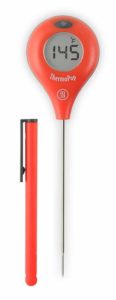 photo: thermoworks.com
photo: thermoworks.com
2. CHEF’S KNIFE
A good quality knife set, or at least a few key knives (chef’s, paring, slicer), is another kitchen essential. An 8-inch chef’s knife is one that can be used for prepping almost everything – fruit, vegetables, meat, and seafood. There are many quality brands and price points available so choose a knife that is lightweight and feels comfortable in your hand, has a non-slip handle, and is made of high-carbon stainless steel.
Some that I recommend are:
- Victorinox Fibrox Pro 8″ Chef’s Knife
- Victorinox Fibrox Pro Santoku
- Shun 7” Santoku
- Wustof Classic 8” Chef’s Knife
- A. Henckels Classic 8” Chef’s Knife
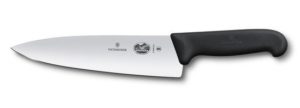
photo: victorinox.com
3. KNIFE SHARPENER
Maintaining a sharp edge on that all-important Chef’s Knife is also important. It may seem a bit intimidating, but with the use of one of these nifty tools, knife sharpening is quite easy to do.
Electric Sharpener:
Manual Sharpeners:
For more information on choosing a knife sharpener, check out Cook’s Illustrated Equipment Review – Knife Sharpeners.
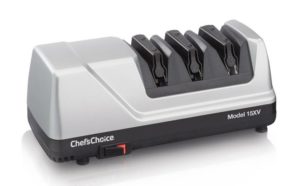 photo: chefschoice.com
photo: chefschoice.com
4. SPATULAS
HEATPROOF SILICONE SPATULA
My heatproof SILICONE SPATULAS are some of the hardest working tools in my kitchen! I love using them for scraping batters and food out of bowls, jars, and other containers, as well as for sautéing and mixing. With many brands available, I look for spatulas that have a stiff blade yet some flexibility for reaching into corners and curves, and I tend to favor those that are constructed in one solid piece.
Some that I recommend are:
- OXO Good Grips Medium Silicone Spatula
- OXO Good Grips Jar Spatula
- Rubbermaid 13.5” High-Heat Scraper
For more information, see Cook’s Illustrated Equipment Review – Silicone Spatulas
METAL SPATULAS
I regularly use both a plain METAL SPATULA for turning vegetables, burgers, and pancakes, and for scraping up those delicious flavor bits from the bottom of metal pans. I also use a FISH SPATULA whose curved edge assists in turning delicate fish and eggs.
Recommendations include:
For more information on choosing metal spatulas, see Cook’s Illustrated Equipment Review – Metal Spatulas.
![]()
photo: oxo.com
5. TONGS
Tongs are handy tools for all sorts of cooking tasks – turning vegetables, meats, seafood, bread slices, tortillas, serving pasta, or transferring any number of food items. I find it helpful to have two sizes and types – one 12-inch with scalloped metal edges and one 9-inch with scalloped silicone edges.
Recommendations include:
For more information on choosing kitchen tongs, see these two Cook’s Illustrated Equipment Reviews – Kitchen Tongs and 9-Inch Kitchen Tongs
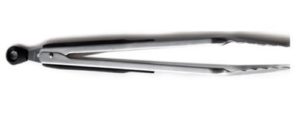
photo: oxo.com
6. TIMER
Many stoves and microwave ovens have digital timers built in, yet it is quite helpful to have a separate kitchen timer available for those times when one is cooking multiple dishes, grilling outdoors, or monitoring baked goods from an adjoining room. Choose a timer that is easy to read, has a range that is acceptable to you, and has an alarm that is easily heard.
Some recommendations include:
- OXO Good Grips Triple Timer
- OXO Good Grips Magnetic Digital Timer
- ThermoWorks Extra Big and Extra Loud Timer
For further information on selecting a kitchen timer, see Cook’s Illustrated Equipment Review– Kitchen Timers.
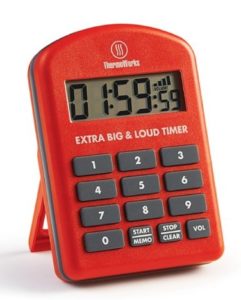
photo: thermoworks.com
7. VEGETABLE and FRUIT PEELER
For those times when I am not using my paring knife, I reach for my vegetable peeler. The most common designs are either straight or Y-shaped, coming down to preference and blade quality.
For more information on peelers, check out two Cook’s Illustrated Equipment Reviews – Vegetable Peelers and Vegetable Peeler for KIDS.
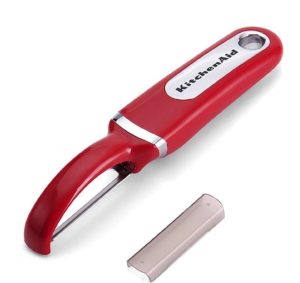
photo: kitchenaid.com
8. KITCHEN SCALE
Weighing ingredients on a digital kitchen scale is critical for consistency and success with many recipes, particularly when making baked goods. I repeatedly recommend my OXO Good Grips 22-lb Food Scale with Pull-Out Display for its ease of use, smooth surface which is easy to clean, accuracy, and durability.
For further information on choosing a kitchen scale, see Cook’s Illustrated Equipment Reviews – Digital Kitchen Scales and Large Capacity Kitchen Scales.
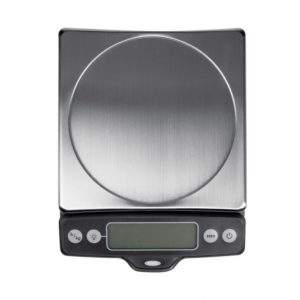
photo: oxo.com
9. WOODEN SPOONS
The most basic of tools, wooden spoons can be used with both hot and cold foods. Look for spoons that are smooth and sturdy. I prefer spoons that have a comfortable, flat-sided handle and a medium-sized head. I particularly like those made of bamboo or beech wood for their durability and resistance to staining.
Recommendations include:
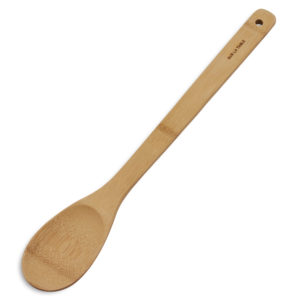
photo: surlatable.com
10. CUTTING BOARDS
Cutting boards come in a variety of sizes and materials. It is generally recommended to have at least two in a home kitchen made of different materials for use with different types of food. If space permits, having more than two is all the better. Plastic cutting boards work very well for meats, fish, and seafood and wood is great for produce and other foods that are not raw proteins. Look for polyethylene or polypropylene plastic, and bamboo or teak for wood. Some wood cutting boards require periodic oiling to maintain. Other materials such as glass, ceramic, granite, and marble are not recommended as they can cause undue harm and damage to knives.
Large-sized cutting boards work best for providing enough chopping space. Small or medium-sized boards are fine for slicing smaller food items, such as a wedge of cheese.
Some recommended cutting board brands include:
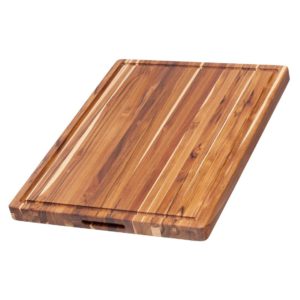
photo: teakhaus.com
11. SAFETY or SMOOTH EDGE CAN OPENER
I highly recommend the use of safety can openers in the kitchen for cooks of any age and ability. It removes the entire rim of a can and leaves a smooth edge which is much safer than traditional can openers. They can be slightly challenging when first used, however, the learning curve is short and worth it. Look for one that fits your hand well and your storage space.
Recommendations include:
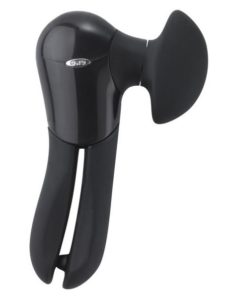
photo:oxo.com
12. MEASURING CUPS AND SPOONS
Having both wet and dry measuring cups, as well as at least one set of measuring spoons makes for a nicely stocked kitchen.
- Wet measuring cups look similar to a pitcher and are typically made of glass or plastic with measures along the side. As the name implies, these are best used for wet ingredients such as water, milk, stock, oil, juice, etc. Look for those with clear numbers, and consider having a small 1 or 2-cup measuring cup along with a larger 4-cup measure.
Recommendation: Pyrex Measuring Cup
- Dry measuring cups look like scoops with the measures posted on each handle. They are typically made of plastic or metal, and are best used for dry ingredients such as flour, sugar, grains, baking chips, oatmeal, etc. Look for those that are smooth from handle to the edge of the rim for the easiest and most accurate measuring.
Recommendations include:
Measuring spoons are generally made of plastic or metal and have the measures posted on the handles. Use them to measure both liquid and dry ingredients. Again, look for spoons that are smooth from the handle to the edge of the rim.
Recommendation: OXO Good Grips Stainless Steel Measuring Spoons
For further information on choosing measuring cups or spoons, check out the equipment reviews conducted by Cook’s Country Measuring Spoons, Cook’s Illustrated Liquid Measuring Cups, and Cook’s Illustrated Dry Measuring Cups.
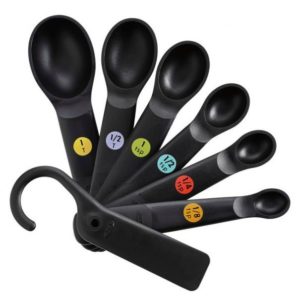
photo:oxo.com
© 2019 Love + Craft Kitchen, LLC, All Rights Reserved
Main photo: Alyson Mcphee on Unsplash

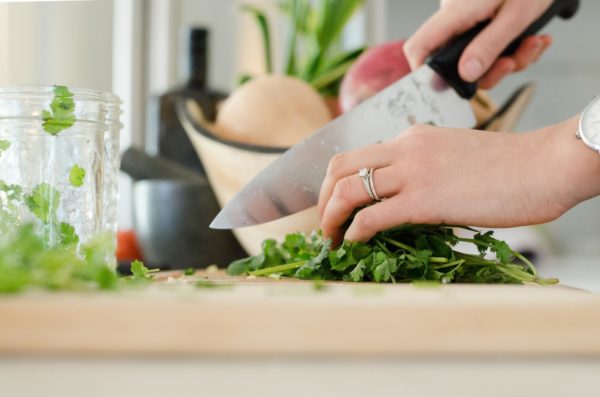
Recent Comments